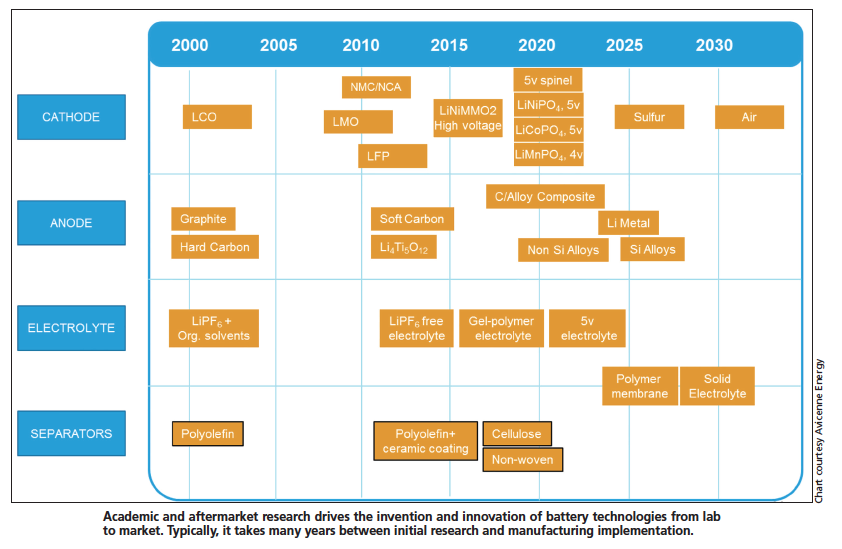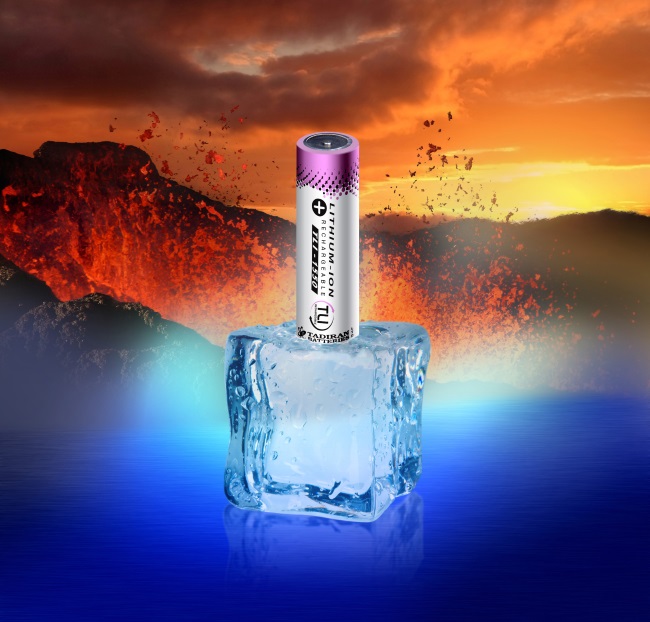Batteries are constantly in the news — mostly about exciting breakthroughs and some reports on problems. Regardless, it’s a thrilling time for batteries and energy storage.
The chemical make-up of batteries and the anode/cathode improvements are where progress occurs for batteries. Some recent examples include the cutting-edge development of solid-state batteries, such as those defined by researchers at the University of Maryland. They have developed intrinsically safe, all-solid-state Li-ion batteries (SSLiBs) by incorporating high-conductivity garnet-type solid Li-ion electrolytes into tailored tri-layer microstructures, by low-cost fabrication techniques, to form electrode-supported dense thin-film (~10 μm) solid-state electrolytes. The porous garnet scaffold support increases interfacial area, overcoming the high impedance typical of planar geometry SSLiBs resulting in an area-specific resistance of only ~2 Ωcm2 . The unique structure further allows for Li-metal, high depth of discharge ability without cycling fatigue. Researchers presented their findings at the 7th annual Battery Safety Conference this past November in Bethesda, MD.
“The first revolutionary technology is the emergence of solid-state batteries,” agreed John Warner, Chief Marketing officer at EnerDel. “The solid-state battery uses a solid electrolyte that is deposited over the cathode and then the anode is coated on top of that.” The two big benefits here are energy density and safety. The solid-state battery has the potential to drive very high energy density into very small battery space. And the use of solid electrolytes means that there is no flammable material in the battery, so a thermal failure is, at the very least, extremely unlikely, if not impossible, to occur. However, Warner continued, at the current state of the technology, solid-state cells are limited to the mAh scale and are mainly applicable for very small applications. We will see this technology begin to take hold in places like medical devices and consumer electronics over the next five years. As the technology matures and larger cells become possible, we can envision a time when they begin to power vehicles and larger applications, but that is still more than a few years away.
Another developing technology trend that shows great promise is the lithium-sulfur batteries. Lithium-sulfur batteries have the potential to offer very low costs due to the sulfur in place of the high-cost nickel, cobalt, aluminum, and other rare earth metals used in current lithium-ion cells. In addition to the low cost, they may offer energy densities in the range of 500 Wh/kg. Current lithium-ion cells range from about 160 Wh/kg up to about 220 Wh/kg, with the maximum limit for current technologies expected to be about 300 Wh/kg. So it may very well be that lithium-sulfur cells will replace current lithium-ion batteries. However, as of today, there are only a handful of companies actively developing lithium-sulfur cells, and none are commercially available. As long as there are no major hurdles that occur, I would expect to see these cells beginning to emerge in product form in about five years and becoming the new standard in between five to 10 years.

Industrial IoT batteries
Advancing technology and the rapid emergence of the Industrial Internet of Things (IIoT), according to Sol Jacobs, VP and General Manager for Tadiran Batteries, have increased demand for industrial-grade wireless sensors that can monitor virtually all external environments. He said that applications involving remote inaccessible locations and extreme environments mainly demand the use of long-life bobbin-type lithium thionyl chloride (LiSOCl2 ) batteries that can power remote wireless sensors for up to 40 years. The ability of bobbin-type LiSOCl2 batteries to deliver long-term reliable performance in extreme environments serves to reduce the total cost of ownership.

According to Mr. Jacobs, the burgeoning IIoT has also created demand for energy harvesting devices used in combination with rechargeable Li-ion batteries to store the harvested energy. Industrial-grade applications often cannot use consumer grade Li-ion batteries that have a limited lifespan of five years and 500 full recharge cycles, along with a limited temperature range and the inability to deliver the high pulses required to power two-way wireless communications. To serve this need, an industrial grade Li-ion battery has been developed that can operate for up to 20 years and 5,000 full recharge cycles and also features an extended temperature range of −40°C to 85°C and can deliver high pulses to support advanced two-way communications.
The battery manufacturers are responding with battery technologies that respond to customer needs for more energy density, lifetime, and safety characteristics for medical, automotive, consumer, and industrial applications. Please find some of the latest products and research available:
Panasonic: pin-type Li-ion battery and flexible Li-ion battery

A rechargeable pin-type lithium-ion (Li-ion) battery (CG-320A, CG-425, and CG-435), as well as its flexible Li-ion battery (CG-062939, CG-063555, and CG-064065), were recently introduced. The pin-type Li-ion battery CG-320A has a nominal capacity of 15.0 mAh with a diameter of 3.65 mm and a weight of 0.6 g. It is suitable for powering small applications such as wearable devices. In addition to being small, the cylindrical-shaped, rechargeable Li-ion battery features high reliability and high output. Applications include wearable devices, active stylus pens, measuring devices, near-field communications, and specialty eyewear.
Tadiran: long-life rechargeable Li-ion batteries

The expanded TLI series offers a family of long-life rechargeable Li-ion cells designed for use in harsh environments. The batteries are available in AA and AAA diameters and custom battery packs. The cells can be recharged using dc power or can be used in conjunction with photovoltaic solar systems or other energy-harvesting devices for long-term power.
Saft: innovative smart grid installation

Saft is supplying its Intensium Flex battery system to supply backup energy for essential command and control equipment for French transmission grid operator RTE to provide vital backup power for its innovative Blocaux smart substations project. The modular Intensium Flex battery system can be built up to closely match the system requirements. The system will deliver 11 kW at 110 V for up to four hours of autonomous operation.
Navigant Research
A report from Navigant Research explores the concept of reusing plug-in electric vehicle (PEV) Li-ion batteries for stationary energy storage system (ESS) applications, focusing on the key issues, market drivers, and challenges related to reusing second-life PEV batteries. Li-ion battery packs in EVs have shown less degradation and better performance than expected thanks to robust pack design and careful thermal and charging management. The study examines the issues, including market drivers and challenges, related to second-life batteries and suggests moves for stakeholders to help make the concept become a reality.
EnerDel
The PP320-738-LP Vigor+ battery pack offers a robust transportation-grade package with built-in system control redundancies to ensure enhanced pack protection and user safety. The packs are designed for transportation power applications such as buses. Each battery pack has 24 cells/module with a maximum of 737 V and a minimum of 450 V. It has a rated capacity of 32 Ah and rated energy of 20 kWh. The maximum pulse discharge is 350 A for 5 s and a maximum continuous charge of 160 A. The pack is designed to accommodate ambient or chilled air.
Tesla
The second-generation home-energy battery-storage unit and a new aesthetic solar roof design were recently introduced. The Powerwall 2 has twice the energy density and capacity of its predecessor and can power a two-bedroom home for a full night. Compact, stackable, and with a built-in dc-to-ac inverter, the new unit costs $5,500 (plus $1,000 for installation and supporting hardware). The included inverter is a new design by Tesla. Its capacity is now 14 kWh, with 7 kW peak output, 5 kW continuous, and a weight of 264.4 pounds.
Advertisement





